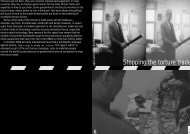CROWD CONTROL TECHNOLOGIES - Omega Research Foundation
CROWD CONTROL TECHNOLOGIES - Omega Research Foundation
CROWD CONTROL TECHNOLOGIES - Omega Research Foundation
You also want an ePaper? Increase the reach of your titles
YUMPU automatically turns print PDFs into web optimized ePapers that Google loves.
Electro-shock weapons have been deliberately, and often repeatedly, applied to sensitive parts of<br />
prisoners' bodies, including their: armpits, necks, faces, chests, abdomens, the inside parts of legs, the<br />
soles of the feet, inside mouths and ears, on genitals and inside vaginas, rectums and on the back.<br />
Such practices are often combined with other forms of torture and ill-treatment, including psychological<br />
torture. In many cases electro-shock weapons are used against women in addition to rape or other<br />
sexual assaults. A Mexican woman, Layda Silva reported how the Cobras security force had used<br />
electro-shock batons on her. )I fell to the ground, but they carried on giving me the shocks - on<br />
my breasts, vagina, stomach, legs, all over my body,(. 293<br />
In March 1997, Amnesty International published a report which documented electric shock torture<br />
and ill-treatment in 50 countries worldwide since 1990. In 18 of these countries there was evidence<br />
that hand-held electro-shock weapons had been used to commit such human rights violations. These<br />
countries included: Algeria, Austria, Bulgaria, China, Egypt, Greece, Lebanon, Russian Federation,<br />
Saudi Arabia, South Africa, Sudan, Turkey, United States of America, Uruguay, Vietnam, Yugoslavia<br />
(Kosovo), Zaire. 294 Despite their stated adherence to the basic principles of international human rights<br />
laws, including ratifying international human rights treaties, governments continue to permit electric<br />
shock torture and ill-treatment in prisons, detention centres and police stations.<br />
Some of these cases have occurred in European member states. In October 1996, the Austrian<br />
government agreed to the publication of a report by a delegation from the ECPT [Council of Europes<br />
Committee for the Prevention of Torture] which contained serious allegations that detainees of Austrian<br />
as well as foreign nationality were at risk of grave ill-treatment particularly while detained at the Bureau<br />
of Security in Vienna. 295 There are also reports of the police use of electric batons against protestors in<br />
Nicosia, Cyprus in March 1996 296 and in States that are seeking membership of the European Union.<br />
For example, in July 1997, the Special Rapporteur of the United Nations Commission on Human Rights<br />
advised the Bulgarian Government that he had received information on what was alleged to be a<br />
substantial incidence of torture or other ill-treatment inflicted by members of the police against street<br />
children, especially those of Roma ethnicity. The ill-treatment, which was said to take place both at the<br />
time of arrest and during detention at police stations, was allegedly carried out to intimidate or extract a<br />
)confession(. The children so detained were reportedly sometimes picked up on suspicion of such<br />
crimes as theft, but might also be arrested as part of generalized )street sweeps(. The abuses<br />
reported included: )beatings with fists, boots, electric shock batons, clubs, chains, rubber hosing,<br />
boxing gloves or a metal rod with a ball attached to its end (beech) and beatings on the soles of the<br />
feet, sometimes with electric batons (falaka)(. 297 Bulgarias police force was re-equipped with new antiriot<br />
equipment in 1990 including electro-shock batons. 298<br />
Recent reports by the United Nations Commission on Human Rights document the use of torture in<br />
a wide range of countries including Turkey. One report stated that the )torture of men, women and<br />
children continues to be widespread throughout Turkey, and people have disappeared or died in<br />
police custody(. 299 Other reports have identified specific police units that practice widespread torture<br />
including electric shock torture and ill-treatment 300 In the United States, the record of electro-shock<br />
weapons is far from unblemished. Prison guards in Arizona, California, New Mexico 301 and Texas<br />
xl<br />
302 303<br />
have been accused of tormenting inmates with stun batons. There have also been allegations that<br />
officers of the INS (Immigration & Naturalisation Service) have used stun weapons against<br />
detainees. 304 The UN Special Rapporteur on Torture raised a series of cases where it had been<br />
reported that stun weapons had contributed to ill-treatment or abuse in the US. 305<br />
Some stun weapon manufacturers and suppliers offer training as a means to ensure safety, but<br />
such training is not available to all those able to acquire electro-shock weapons. The human rights<br />
content of training courses appears to be weak or non-existent. One US course manual claims that<br />
"should an officer misuse or abuse someone with less-than-lethal electronic weaponry, the<br />
consequence or error could, at the very worst, be a minor non-permanent injury." The evidence in this<br />
report shows how misleading such statements are. US law enforcement officers who have received<br />
training in the use of stun guns, report using them variously on assailants for 1 to 2 seconds on the<br />
legs, but also on the torso for 3 to 5 seconds. The Amnesty International report quotes a 1992 report




